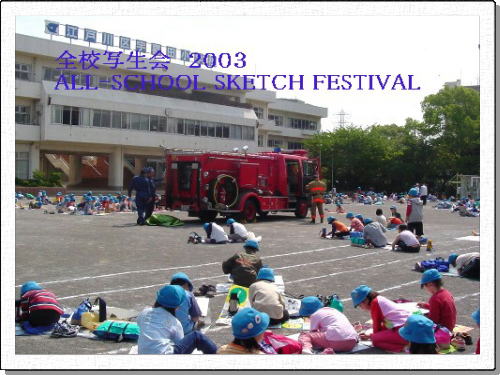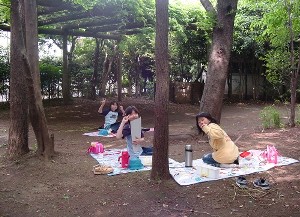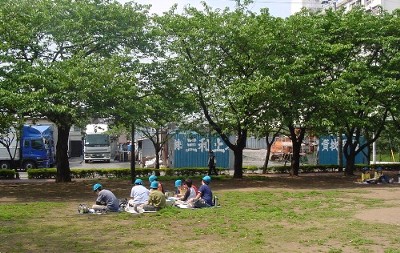

5年 宇喜田の森
5th Grade"Ukita Woods"
宇喜田小学校
Ukita Elementaly School
Welcome to the Spring 2003 Ukita Student Gallery "ALL-SCHOOL SKETCH FESTIVAL"

6年 宇喜田さくら公園 6th Grade"Ukita Cherry Park"
 |
 5年 宇喜田の森 5th Grade"Ukita Woods" 宇喜田小学校 Ukita Elementaly School |
|
| Welcome to the Spring 2003 Ukita Student Gallery "ALL-SCHOOL SKETCH FESTIVAL" |
||
 6年 宇喜田さくら公園 6th Grade"Ukita Cherry Park" |
||
|1年1st Grade|2年2nd Grade|3年3rd Grade|4年4th Grade|5年5th Grade|6年6th Grade|宇喜田美術館Ukita Art Museum|
|写生会写真Photograph|生徒の様式Styles in landscape paintings|1.全校写生会のねらい (1)新緑の中で地域や学校を見つめ,消防車を含めた写生をすることにより,描く喜びを味わい,創造的に取り組む態度を養う。(開校20周年)
[図画工作科と総合的な学習の時間(地域の特色)]
(2)自分の作品や友達の作品を見合うことにより,そのよさや表し方の違いなどがわかり,見方や感じ方を深めるようにする。 [図画工作科(鑑賞)]2.図画工作科ねらい
Art Education
A) ObjectiveA 表 現
表したいことを表すために,形や色,材料などを生かし,それらの組合せの感じに関心をもち,美しさや用途などを考え,計画を立てるなど工夫して表すこと。
Expression
1.To draw out from each student a desire to creatively express. Help children develop their artistic ability, encourage them to create their own ideas, and give them exposure to various artistic views and styles.
B 鑑 賞
自分たちの作品のよさや面白さなどについていろいろな表し方や材料による感じの違いなどが分かり,関心をもって見ること。
Art Appreciation
1.Encourage students to be able to discover the quality and interesting aspects of various art pieces.
In looking at their own works, help the students to recognize the many differences in artistic expression and the diverse effects of using particular materials.3.「総合的な学習の時間」ねらい
"Period for Integrated Study"
B) Objective(2) 学び方やものの考え方を身に付け,問題の解決や探究活動に主体的,創造的に取り組む態度を育て,自己の生き方を考えることができるようにすること。
It also aims at helping children learn how to learn and reason, develop mind to independently and creatively cope with problem-solving activities and/or inquiring activities, and deepen their understanding of their own way of life.
 2-1 |
 2-2 |
 2-3 |
 2-4 |
 2-5 |
 2-6 |
 2-7 |
 2-8 |
 2-9 |
 2-10 |
 2-11 |
 2-12 |
 2-13 |
 2-14 |
 2-15 |
 2-16 |
 2-17 |
 4-1 |
 4-2 |
 4-3 |
 4-4 |
 4-5 |
 4-6 |
 4-7 |
 4-8 |
 4-9 |
 4-10 |
 4-11 |
 4-12 |
 4-13 |
 4-14 |
 4-15 |
 4-16 |
 4-17 |
 4-18 |
 4-19 |
 4-20 |
 4-21 |
 4-22 |
 4-23 |
 4-24 |
 4-25 |
 4-26 |
 4-27 |
 4-28 |
 4-29 |
 4-30 |
 4-31 |
 4-32 |
 4-33 |
 4-35 |
 4-36 |
 4-37 |
 4-38 |
 5-1 |
 5-2 |
 5-3 |
 5-4 |
 5-5 |
 5-6 |
 5-7 |
 5-8 |
 5-9 |
 5-10 |
 5-11 |
 5-12 |
 5-13 |
 5-14 |
 5-15 |
 5-16 |
 5-17 |
 5-18 |
 5-19 |
 5-20 |
 5-21 |
 5-22 |
 5-23 |
 5-24 |
 5-25 |
 5-26 |
 5-27 |
 5-28 |
 5-29 |
 5-30 |
 5-31 |
 5-32 |
 5-33 |
 5-34 |
 5-35 |
 6-1 |
 6-2 |
 6-3 |
 6-4 |
 6-5 |
 6-6 |
 6-7 |
 6-8 |
 6-9 |
 6-10 |
 6-11 |
 6-12 |
 6-13 |
 6-14 |
 6-15 |
 6-16 |
 6-17 |
 6-18 |
 6-19 |
 6-20 |
 6-21 |
公園を描く学習は創造的です。(ジャパン・タイムズ)Friday, July 19, 2002
Painting in the park is a lesson in creativity
●ジャパン タイムズより取材を受け、全校写生会の意義を記事にしていただきました。
The Japan Times: July 19, 2002 By ALICE GORDENKER
The All-School Sketch Festival is a wonderful and worthwhile event, and I hope it continues.
風景画の様式 Many Styles in Landscape Painting
美術には多くのスタイル(審美的な姿勢)があります。
ほとんどの生徒は、個人的なスタイルまたは特有の筆跡を発達させます。
There are many styles (aesthetic stances) in visual art. Most students
develop very personal styles or unique handwriting.
 2-15 |
 5-34 |
[1]自然主義Naturalismと写実主義Realism 眼に見えたものを、リアルに表そうとしています。 自然主義あるいは自然主義-それが型にはめられたり、知的に操作されたやり方で表わされることに対立するものとして、芸術家が自然界を正確に客観的に表現するスタイル。 Naturalism or naturalism - A style in which an artist intends to represent a subject as it appears in the natural world -- precisely and objectivly -- as opposed to being represented in a stylized or intellectually manipulated manner. Although naturalism is often used interchangeably with the term realism, there is a difference between them. The realism of Gustave Courbet (French, 1819-1877) is more interested in the honest depiction of unpretentious subjects, while the naturalism of Ernest Meissonier (French, 1815-1891) is more a visually accurate depiction of subjects which in other hands might well have been depicted pretentiously. |
 4-5 |
 6-20 |
|
 2-5 |
 5-11 |
[2]印象主義Impressionism 見て、感じ得たものを描こうとしています。 マネ,モネのほかルノアール,ピサロ,シスレーらが代表的画家。彼らは写実主義,自然主義に共感し,クールベらを受け継いで,形式美を排し,対象の個性的特徴を表現することを目標とした。その結果,物体には固有の色はなく,光線によってたえず変化する色を大気とともにある瞬間にとらえねばならぬこと,影は暗黒ではなく微妙な色彩があることなどを主張し,これを表現するため,絵具の混色をやめ,純粋な色に分解してカンバス上に並置し,また点描によって光感を高めるなどの技巧を用いた。色調は明るく,主題を多く戸外に求めたため〈外光派〉とも呼ばれる。 An art movement and style of painting that started in France during the 1860s. Impressionist artists tried to paint candid glimpses of their subjects showing the effects of sunlight on things at different times of day. The leaders of this movement were: Camille Pissarro (French, 1830-1903), Edgar Degas (French, 1834-1917), Claude Monet (French, 1840-1926), and Pierre Renoir (French, 1841-1919). |
 4-13 |
 6-4 |
|
 2-13 |
 5-14 |
[3]表現主義Expressinnism 平面的で激しい筆触や対象の単純化などが見られる主観的な表現です。 表現主義は、主題を正確に再生しないで、芸術家の内部の状態を表現するような方法の芸術スタイルです。その運動はドイツに特に関係していて、象徴主義、野獣派および立体派のような情緒的に強烈なスタイルによって影響を受けました。 Expressionism is a style of art in which the intention is not to reproduce a subject accurately, but instead to portray it in such a way as to express the inner state of the artist. The movement is associated with Germany in particular, and was influenced by such emotionally-charged styles as Symbolism, Fauvism, and Cubism. |
 4-14 |
 6-5 |
|
 2-11 |
 5-33 |
[4]フォービズムFauvism 強烈な色彩と大胆な方法で表現しました。 20世紀初頭のフランスの絵画の動向で、鮮やかな純色と大胆な筆触とを特色とする。1905年のサロン・ドートンヌの一室に展示された一群の画家たちの作品をある評論家が“野獣の檻”と揶揄したのが名称の由来。ゴッホやゴーギャンの系譜をくみ、再現性に拘束されない自律的な色彩と造形性には、同時代のドイツの表現主義の深刻さとは異なった、感覚的な解放感がある。マチス、ドラン、マル ケ、ブラマンク、ルオーら。 An early twentieth century art movement and style of painting in France. The name Fauves, French for "Wild Beasts," was given to artists adhering to this style because it was felt that they used intense colors in a violent, uncontrolled way. The leader of the Fauves was Henri Matisse (French, 1869-1954). |
 4-4 |
 6-11 |
|
 5-17 |
 6-13 |
[5]新印象主義Neo-Impressionism 印象主義への派生や反応としての絵画の運動。それ、ジョルジュ・ピエール・スーラ(フランス語、1859-1891)(この人は、純粋な色のタッチかドットの科学的な並置に基づいて、点描画法(分割主義、あるいはconfettiismと呼ばれる技術を使用した)によって起こされました。彼の最も有名な絵画は「グランドジャット島の日曜日」1884-1886、シカゴ美術館の所蔵。他の新印象主義派はカミーユ・ピサロ(フランス語、1830-1903)、ポール・シニャック(フランス語、1863-1935)。 Neo-Impressionism or neo-impressionism - A movement in painting which was an outgrowth of and reaction to Impressionism. It was originated by Georges-Pierre Seurat (French, 1859-1891), who employed a technique called pointillism (also called divisionism, or confettiism), based on the scientific juxtaposition of touches or dots of pure color. His most famous painting is A Sunday on La Grande Jatte, 1884, 1884-1886, oil paint on canvas, in the collection of the Art Institute of Chicago). The brain blends the colors automatically in the involuntary process of optical mixing. Other neo-impressionists include Camille Pissaro (French, 1830-1903), Paul Signac (French, 1863-1935), Theodoor van Rysselberghe (Belgian, 1862-1926), and Henry Edmond Cross (French, 1856-1910). |
 5-31 |
 6-21 |
|
 2-9 |
 6-8 |
[6]素朴派naive art or naive art 正規の美術教育を受けず、画壇とも無縁であり、独学で、仕事のかたわら、自分の描きたい対象を、アカデミックな遠近法・明暗法・構図・色調に束縛されることなく、感知するまま丹念に描く画家たちを一般に素朴派(ナイーフ派)という。また、原始美術や幼児美術、あるいは精神病者の作例などを含む場合もあり、ある特定の時期のみにみられる造形的現象ではない。一九世紀末から二〇世紀初めのアンリ・ルソーの存在と、その紹介者ウィルヘルム・ウーデによって注目されるようになる。 The style of naive painting is characterized by a careful, simplifying approach, non-scientific perspective, bright colors, and often, an enchantingly literal depiction of imaginary scenes. Although not following any particular movement or aesthetic, naive painters have been a continuing international phenomenon and influence since the beginning ot the twentieth century. The term usually refers to works produced by artists (also called naifs or naifs) who had no formal training. Some trained artists, however, have deliberately affected a naive style. |
 5-29 |
||
 2-12 |
 5-35 |
[7]障壁画、装飾スタイル The decorative style in Momoyama Art 桃山時代の襖絵は障壁画とも呼ばれ、より装飾的で豪華なスタイルを開発しました。 「Pictures on Fusuma are also called "Pictures on movable walls" (shoohekiga). Another name for fusuma is "Chinese Paper Sliding Door" (karakami shooji).Hasegawa Tohaku, a contemporary of Eitoku, developed a somewhat different and more decorative style for large-scale screen paintings. 」 Momoyama Art https://www.metmuseum.org/toah/hd/momo/hd_momo.htm http://www.art-and-archaeology.com/timelines/japan/momoyama.html |
 5-18 |
 6-20 |
|
 5-20 |
[8]光線主義レイヨニスム Layonnisme, Luchizm 光線主義と訳される。ロシア語では「ルチズム」。 「1910年前後から14年にかけて、ロシアのM・ラリオノフやN・ゴンチャロヴァ等によって実践された絵画様式。光線や光の束を描くことを特徴とする点で、動きを示す為に線を描いた未来派と様式上の類似点を多くもつ。」 事実、13年にモスクワで開かれた展覧会「標的」に際して出版された論集のなかの、ラリオノフの手によると考えられているマニフェストでは「レイヨニスムは、キュビスム、未来派そしてオルフィスムの綜合である」と述べられている。ここから推察されるように、レイヨニスムは線、リズム、色彩の綜合的な関係を画面上に表現することを目標とした。 luminosity - A quality seen in some paintings of a glow coming from within, the illusion that there is actually a light coming out of the picture. Glossy colors are more likely to provide this luminous effect than matte colors. Also see brilliance, candela, optical mixing, and value.L |
|
オン・ライン資源:On-line resources:
ウィキペディア :https://ja.wikipedia.org/wiki/Portal:%E7%BE%8E%E8%A1%93
カテゴリ:文化と芸術のポータル美術
artscape現代美術用語辞典lhttps://artscape.jp/dictionary/modern/
ARTLEX art dictionary
https://web.archive.org/web/20160905145612/http://www.artlex.com/
![]() インターネットで、いつでも、どこでも、アーティスト体験をしよう!
インターネットで、いつでも、どこでも、アーティスト体験をしよう!
New internet art workshops are as follows:
Incredible Art Lesson Plans この活動は、外国よりリンクされています。
Art Lesson Plans from Ukita Elementary, Tokyo, Japan. See these art lesson plans:
![]() 小学校図画工作科/ The Home Page of Art Education
小学校図画工作科/ The Home Page of Art Education
Written by Makio Kawashima
6/7/2003
Last Updated on 2/22/2024
Copyright (C) 2009-2024 Art e-Learning Center. All right reserved.